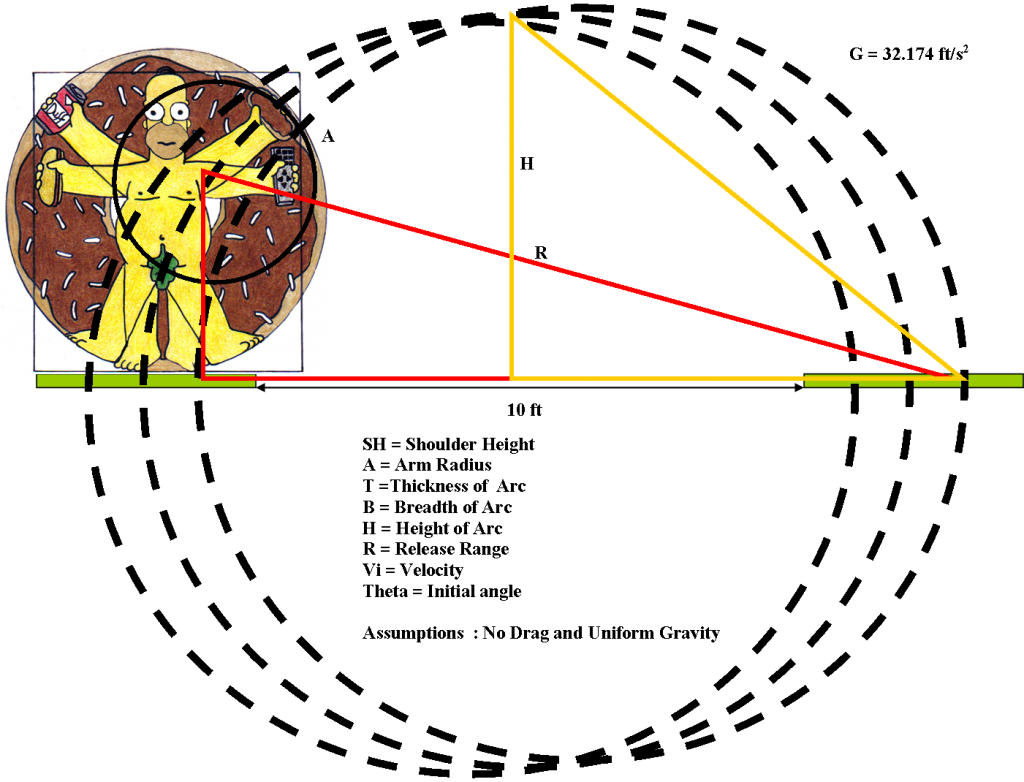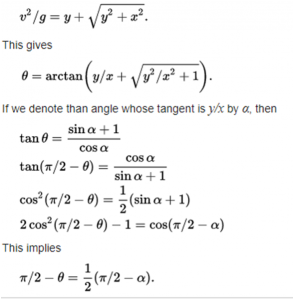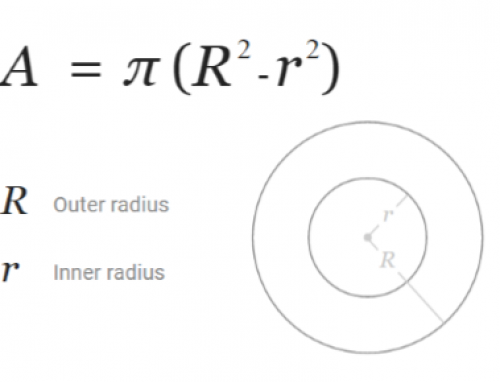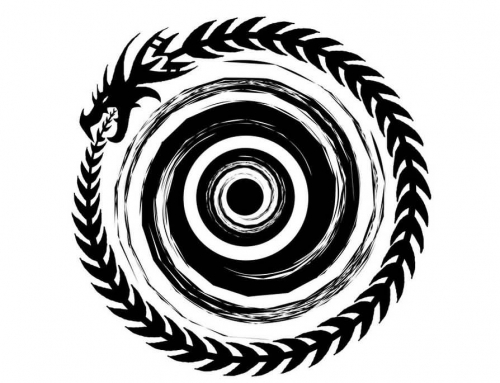Perfect Washer Throwing Science
Based on your weight, height and arm length what does the perfect throw look like?

Diagram 1
This is relatively easy to calculate using basic math, (this math was first used to calculate arrow, spear and cannonball launches).
Items we need to consider:
- Span or Range
- Height of arc
- Thickness of arc
- Breadth of arc
- Velocity
- Displacement
- Time of Flight
- Gravity – Gravitational calculations are based off of the combined effects of gravity and centrifugal acceleration from the rotation of the earth
The Washer Throwing Formula
To hit a hole with a washer with a Range x and altitude y when fired from arm height and arm length (0,0) and with initial speed v the required angle(s) of launch θ are:

So what angle allows the lowest possible throw velocity? This requires solving a quadratic equation for v2, and we find:

To dumb this down just know as a general rule the throw should be at the angle halfway between the target and the zenith.
Calculate Your Perfect Release Angle and Arc Height
If you email your measurements below sa@throw125.com I can calculate the ideal angle and ideal height needed for optimal washer throwing, increasing your probability of getting a 125.
Procedure
- Take off clothes and stand arm’s stretched wide as in Diagram 1.
- Use tape measure to the length of your wingspan [tip of middle finger of one hand to the top of the middle finger of the other hand]. Record length WING SPAN______.
- Send your Height ____ and Measure and record your shoulder height in washer throwing position. SH______
- Stretch out one arm and measure the length from arm pit to wrist. Record Arm Length. ______
- Grasp Washer in your hand like you are ready to throw and measure the length of hand with washer [from the wrist to the tip of washer]. Add Hand Measurement to Arm length and this will be your ARM RADIUS. A _____
- Now, take a piece of rope and tie around the washer and hold washer in your hand again.
- Get into a standard throwing position and hold the washer where you normally release it. Stretch the rope to the hole you are aiming at and cut the rope at the hole. (do this for all three holes if you want specifics)
- Measure the rope and this is your SPAN or RANGE______
- Time: Now throw a washer and time how long it takes to get from throw to hole. t______
- Weigh the washer (1.633lbs for 3.5” washers) and finally Weight yourself. W_____
That’s it send me the information and I’ll calculate H or Height of Optimal Washer arc per hole. (Plug the info into my excel spread sheet and pop out an answer)
DIY Calculations
Things we do know:
- Boards are 2” Thick
- Boards are 10’ apart
- Breadth of Arc is 3.5”-4.5″
- Thickness of Arc is 3.5”-4.5″
- Gravity is a constant 32.174 ft/s squared
Assumptions: Gravity is Constant, we are not playing on the moon, Washers have negligible drag. Sun light will not be directly in your eyes. Air resistance, cross winds, and target alignment cause small variations. I will report answers with a + or – 2 degrees of angle variation or + or – 6 3/4” of height variation. For speedy results please send beer with measurements.
So if you are using the formulas above and don’t want me to do it:
- Calculate velocity Vi
- Calculate Range to all three holes R1, R2, R5
- Calculate Arc
- Finally calculate Angle of Launch
Fun fact if you are like me:
And you’re 72 inches tall and you have a wing span of 73.8 inches your ratio is 1:1.025
And if your forearm is 11 inches and your hand is 8.8 inches your ratio is 1:1.25
Throw 125!





Leave A Comment